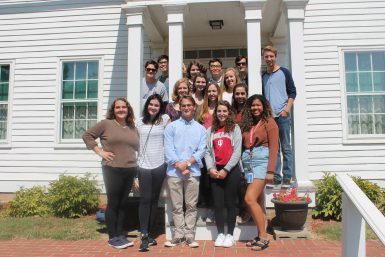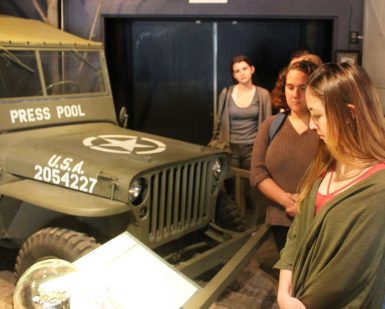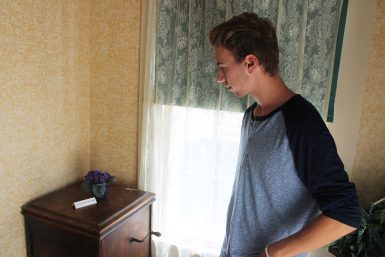New scholars visit Pyle museum, childhood home

Each year, The Media School invites up to 16 high school students from all over the nation to the Ernie Pyle Scholars program. The program includes numerous experiences and trips, including a trip to the Ernie Pyle World War II Museum in Dana, Indiana.
On Saturday, Sept. 9, the freshman Ernie Pyle Scholars took the two-hour trip to visit the museum honoring their program’s namesake. IU not only celebrates Pyle for his work as a student, but also for his great contributions to the citizens of the United States during his coverage of World War II. Pyle spent time from 1939-1945 reporting firsthand war stories so the American people could see the harsh truths of what their soldiers were experiencing.
While at the museum, the scholars toured exhibits showcasing Pyle’s everyday life in war and took a tour of his childhood home. Along with learning about Pyle’s life, students also got a view of life in the early- to mid-1900s.
Read below for trip reports from these scholars.
Ernie Pyle Scholars learn about namesake
By Gillian Paxton
A group of IU students gathered outside two original World War II Quonset huts to view a single plaque, illuminated by the early September sunlight. Despite being nearly 80 years old, the words emblazoned on the plaque still seemed alive with meaning:

“When we leave here for the next shore, there is nothing we can do for the ones beneath the wooden crosses except perhaps to pause and murmur ‘Thanks pal.’”
Led by tour guide Eric Daniels, the Ernie Pyle Scholars saw artifacts and dioramas depicting Pyle’s various travels with the common soldiers in WWII and listened to recordings of his articles. They were struck by the depth of emotion in his writing. From small, humorous accounts of the daily trials of life on the front lines to soaring, tragic tales of fallen comrades, Ernie Pyle documented it all and became a hero to those back home.
The artifacts included a newly added, chrome-plated Coleman camp stove, similar to one given to Pyle after he raved about how useful it was for the soldiers. Another artifact was the wallet he carried until his death on the Japanese island of Iejima.
Together, all these artifacts, photos and articles created a tangible picture of the life of one incredible journalist, beloved by a country and now remembered by so many more than just those living in that small Indiana town.
Humble beginnings preceded worldly accomplishments
By Jessica Kelly
After our education of Ernie Pyle’s accomplishments in the Quonset huts, the Ernie Pyle Scholars walked outside toward an 1851 country estate house.

When describing this house, the first word that comes to mind is “quaint.” The walls were wooden and painted a pristine white. Lacy white drapes adorned the windows. Butterflies swarmed the flowers outside the building.
Following our tour guide, Joanie Rumple, into the sitting room where Ernie Pyle was born on Aug. 3, 1900, the group approached father William’s rocker, aunt Mary’s clock and Ernie’s checkerboard. In the bedroom, we learned that large headboards on the backs of beds kept the chill from seeping in through the walls. Fireplaces were in nearly every room, and large stoves in the dining room and the kitchen generated heat in winter and at night.
Heat was not the only commodity that Pyle and his family would have had trouble acquiring. As we were introduced to chamber pots, side-crank butter churners, razor strops and water pails, the small group of aspiring journalists began to truly appreciate how simple the great Ernie Pyle’s origin story is.
The man who witnessed the Blitzkrieg, the man who traveled with soldiers through North Africa, Sicily and Italy, the man who witnessed the aftermath of the Battle of Normandy and the liberation of France, all without a weapon. The man who lived through the Battle of Okinawa only to die in Iejima. That man was born in the room of this drafty, old house that his family did not even own in a town that in 2017 only has about 600 residents.
The Pyles were tenants of James P. Elder, the man who owned the house we toured. Never in his life did William Pyle own land. Ernest Taylor Pyle had a humble beginning in this world, and despite all the great things he did, he kept his humble personage. Touring his birthplace, witnessing children biking on the streets and visiting a homey restaurant called Off the Tracks Cafe made for a trip of rural Indiana that, no matter how far we make it, will humble the minds of the freshman Ernie Pyle class for a long time.
More:

